With no fewer than 14 elements arranged in 12 groups and a minimum focus distance of 33.46 in. (85cm), this new lens adopts a complex optical construction. To help reduce chromatic and spherical aberrations, two of those 14 elements are low-dispersion SLD glass types, while a third is an aspherical-shaped lens.
The new model features improved environmental protection over earlier lenses in the lineup. In addition to oleophobic coatings on the front and rear lenses, the lens mount features rubber sealing for protection against dust and moisture, though it’s not certain that the lens has further sealing elsewhere.
As an HSM model, this new lens has a sonic-type AF motor with full-time manual focus override in both single and continuous AF modes, which will garner additional favor among hard-core back-button AF users. Fortunately Sigma has adopted a newly-developed motor with 1.3x the torque of its predecessor to handle this large lens.
Priced around $1199, this new lens isn’t quite as affordable as the earlier models in the Art line, but it’s only around $230 over its predecessor and remains competitive enough to tempt those considering the lower-end models of top-tier brands.
With an 86mm accessory thread, and weighing 39.9 oz (1,132g), the new Sigma 85mm F1.4 HSM DG A is larger than any previous models in the Japanese-made Art line as well as those of most competitors, save perhaps for the Otus equivalent from Zeiss.
Improved uniformity, if at the expense of peak sharpness
The Sigma 85mm F1.4 HSM DG A achieved a DxO Mark score of 48 points and peak sharpness 40 P-Mpix on the 50-MP Canon EOS 5DS R. That’s a slightly lower overall score when compared with the Nikon-mount version of the lens on the 36-MP Nikon D810, but a marginally higher sharpness score. While the results aren’t directly comparable due to the difference in the sensors, the 40 P-Mpix sharpness score is perhaps a little disappointing for Canon.
In our image quality rankings, the Sigma is a whisker behind the Zeiss Apo Sonnar T* 2/135 ZE — the highest performing lens in our database on the Canon EOS 5DS R, and marginally surpasses the outstanding Zeiss Otus 1,4/55 and 1,4/85 in the lab.
As with many modern designs, the Sigma has very high sharpness across the image field at the initial aperture. It reaches peak sharpness levels at around f/2.8-4, though it achieves optimum performance across the field one stop down at f/5.6, with levels decreasing slightly on the Canon at f/8 due to diffraction. As seen with the Nikon-mount version, the Sigma is well-corrected for both distortion and lateral chromatic aberration. There is some vignetting, however, and although very low at –0.5EV in the corners, it is unusual in that there’s just a small central core that’s unaffected.
Sigma 85mm F1.4 DG HSM A Canon vs. Sigma 85mm F1.4 EX DG HSM Canon
Sigma was in no hurry to replace its predecessor, the Sigma 85mm F1.4 EX DG HSM, as it was already an excellent performer. Indeed, on the still relatively-new 50-MP Canon EOS 5DS R, it’s an outstanding performer.
Introduced some seven years ago, it followed the trend at the time for high center sharpness wide-open, with noticeable softening towards the outer zones. On the Canon EOS 5DS R, this characteristic continues to f/4, and it’s not till f/5.6 that the periphery starts to come close to the performance of the center. By f/8, sharpness levels are in decline, due to the softening effect of diffraction, but it’s only then that sharpness levels are consistent across the frame. Chromatic aberration and distortion are both well-corrected on the older model, but it’s still not in the same league as the new Art lens.
The new lens has low lateral chromatic aberration across the whole image field, and it remains so when stopped down. Vignetting on the older model is heavier, but it’s also quite typical in its distribution. That contrasts with the new model’s fall-off across a larger proportion of the image field, which is arguably less attractive visually.
Nevertheless, while the EX lens is still considered an excellent performer overall and reasonably priced at around $969, compared to the outstanding corner-to-corner sharpness of the new model, it’s perhaps a lot more different than the scores suggest.
Sigma 85mm F1.4 DG HSM A Canon vs. Canon EF 85mm f/1.2L II USM vs. Carl Zeiss Apo Planar T* Otus 85mm F14 ZE Canon
In our second comparison we’ve pitched the new Sigma 85mm F1.4 HSM DG A Canon-mount model against Canon’s highly-regarded EF 85mm F1.2L II USM and the Zeiss Otus 1,4/85. With a $700 premium for the Canon and an eye-watering $3291 extra for the Otus, few would deny that the Sigma already looks attractive. (Zeiss offers the 85mm F1.4 Milvus, which is cheaper at around $1800, but we’ve not yet had a opportunity to test it on the Canon EOS 5DS R.)
Unsurprisingly, perhaps, both the Canon and Otus perform well, especially the newer, more-modern and pricier Otus over the 11-year old Canon. With good sharpness in the center at the initial aperture, but with rather high levels of lateral chromatic aberration, Canon’s highly regarded L-series model is beginning to show its age. In contrast, the Zeiss is exceptionally sharp wide-open, slightly sharper even than the Sigma in the center, and that more or less continues throughout the aperture range. When stopped to f/2.8, the Canon holds up well centrally, but has some astigmatism in the outer field, perhaps accounting for its highly-attractive rendering or drawing style.
By f/5.6, the Canon is almost as sharp across the frame as the other two, and has excellent symmetry. Where the Sigma scores a few extra points in our metrics is in its control of distortion and to a lesser degree, vignetting, but neither are particularly troublesome to correct with software.
Conclusion
With the introduction of each new model to its Art line, Sigma continues to garner praise as a high-end lens maker, and this new lens secures that status. While all of the full-frame Art line lenses are excellent performers, the Sigma 85mm F1.4 HSM DG A is an outstanding example of the maker’s craft.
At $1,199, it is admittedly unlikely to be bought on a whim. However, not only does it outperform Canon’s highly-regarded EF 85mm F1.2L II USM, but it also displaces the exceptional Zeiss Otus 1,4/85 as the best-performing high-speed 85mm lens in our database. Quality like this never comes cheap, they say, and yet Sigma continues to demonstrate that its Art line models are the exception rather than the rule.


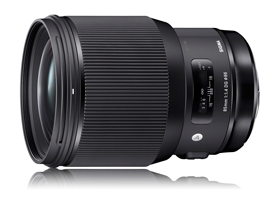


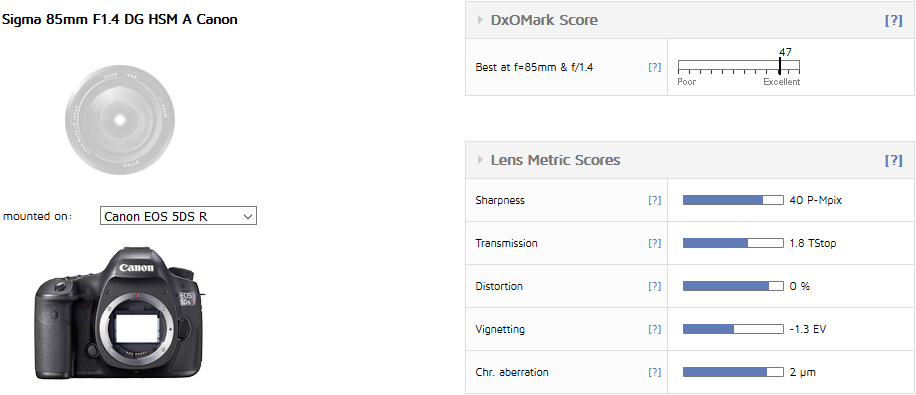
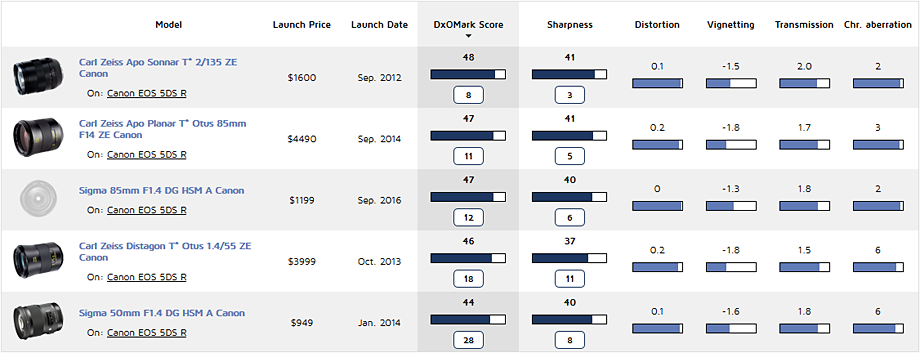
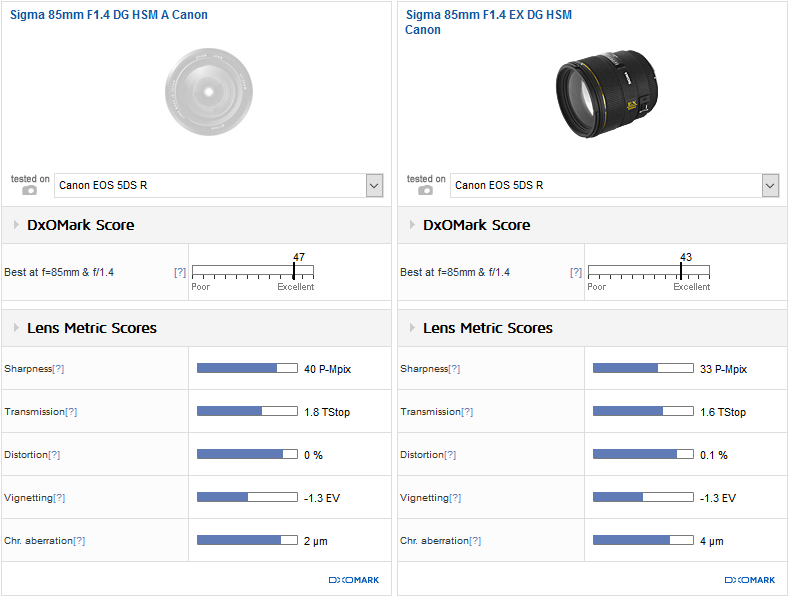
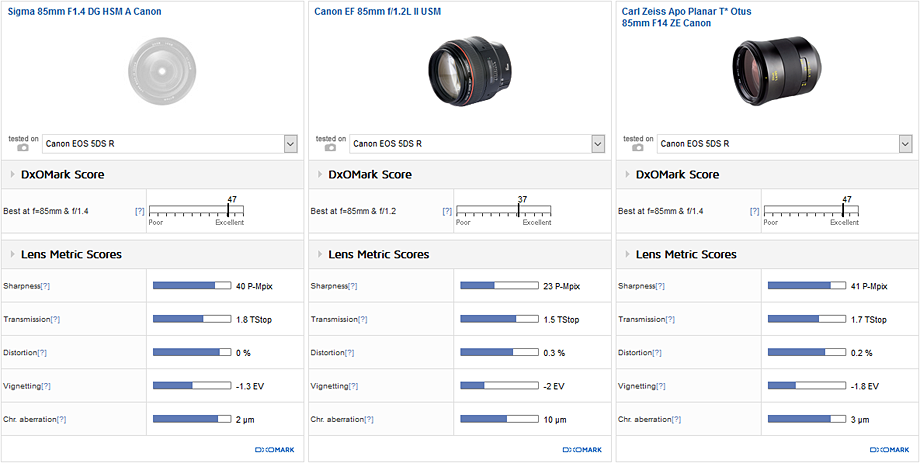
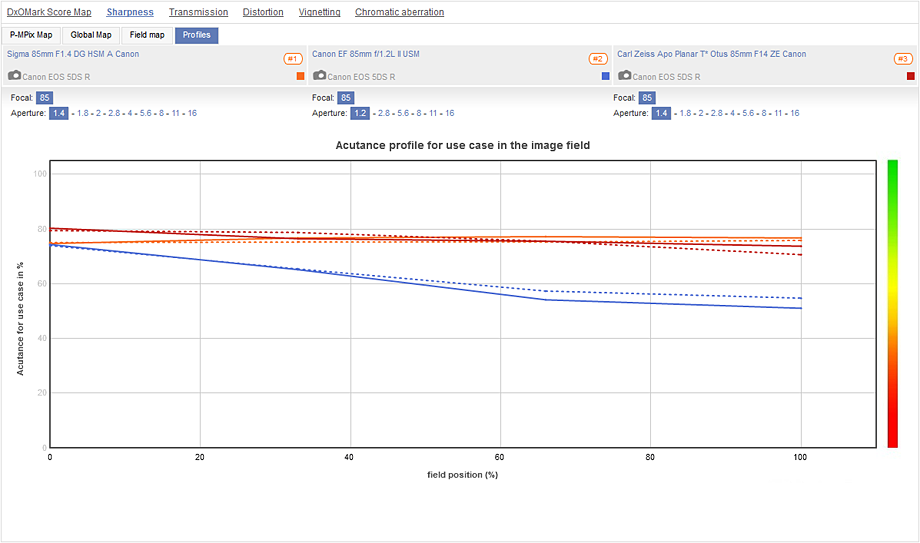
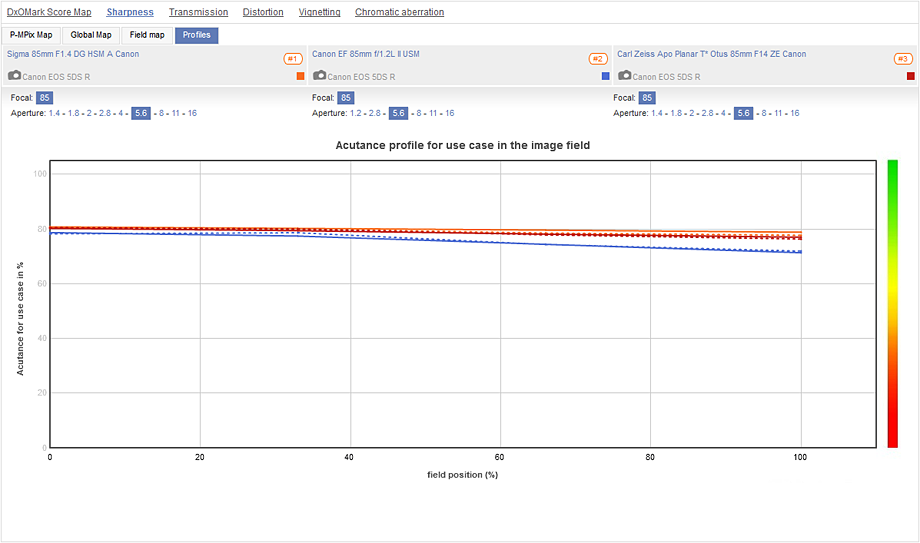
DXOMARK encourages its readers to share comments on the articles. To read or post comments, Disqus cookies are required. Change your Cookies Preferences and read more about our Comment Policy.